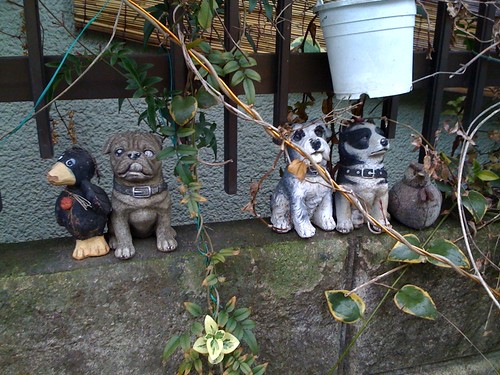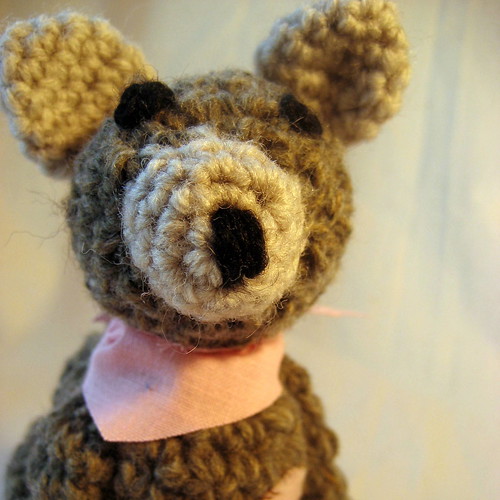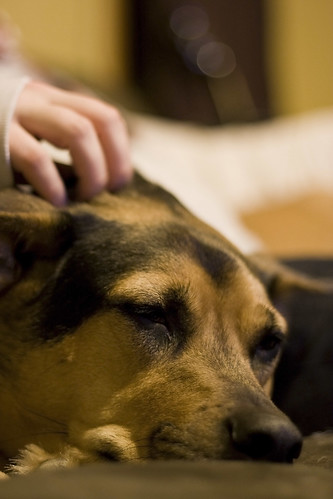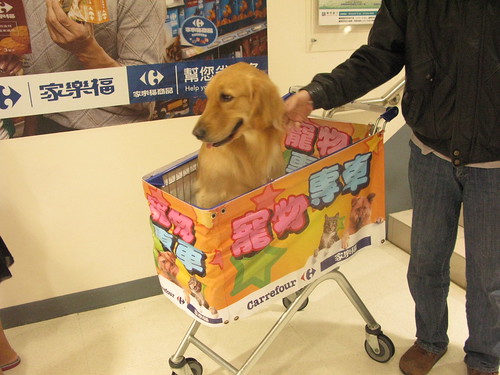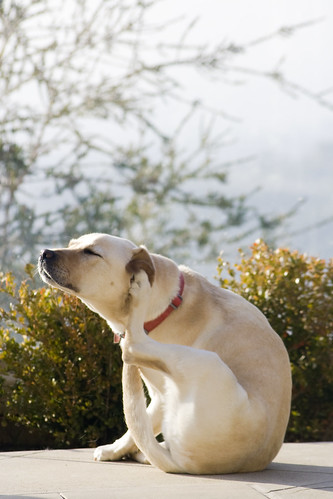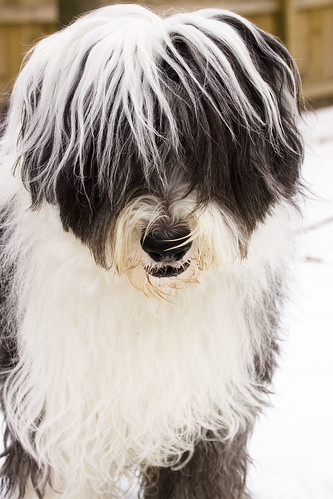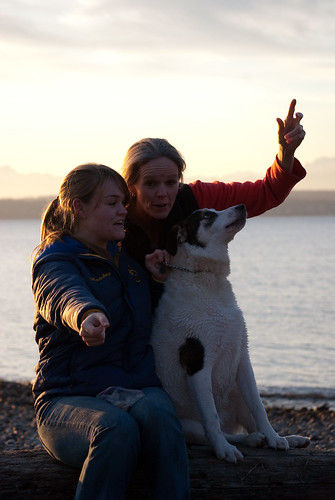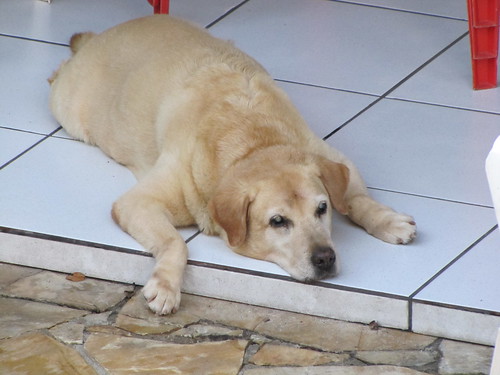
Image : http://www.flickr.com
OK, how dumb AM I? Wait, don't answer that!!!
My 9 year old Cardigan Welsh Corgi Gizmo, also known as Schizzle, needs some anger management classes when it comes to the three boxers next door. They are not great dog neighbors, since their owner leaves the three dogs out to do as they please, and what seems to please them the most is tormenting my dogs through the fence. Gizmo is a classic reactive dog when it comes to the boxers, acting like a totally different dog, working himself into a frenzy about these boxers. He started taking out his frustration on the fence, grabbing with teeth, pulling off bits and pieces of wood before I can get out there to stop him. The hole in the fence is nearly big enough now that he can get his head and shoulders through, and he launches himself into the hole thinking he can squeeze the rest of him through (think Pooh bear stuck in the tree). I think that won't be far off, if I don't figure out how to put something over that hole that he won't just chew again. I really thought that putting in a privacy fence, and leaving a 32 inch empty space then leaving the already existing chain link fence between Giz and the boxers would do the trick because they wouldn't see each other, silly me.
Recently, the neighbor has been leaving obnoxious boxers outside more and more. And Gizmo has been getting in more and more trouble, and any outing outside usually has me standing in the rain, the sun, the heat, the cold, whatever, blocking Gizmo's access to that hole. Then he runs around me in a wide arc, just out of my reach, spitting as he barks because he’s frothing in his frenzy, barking at me, at the boxers, and out of frustration that he can't get closer. The scenario ends with me herding him into the house, because I will not let my dogs stay outside and bark like fools. It gets really old, and I was about to restrict Gizmo to walking in the front yard on a flexi leash and not let him in the back yard. That made me mad, because if my neighbor would make his dogs behave, and not leave them out there to bark all day, I wouldn't have this problem. My dogs can be out, and if his dogs are not barking and lunging at my fence, Gizmo can behave and not have a hissy fit. But “Boxers without Manners” is the real world for so many of us with doggie neighbors.
SO, I've tried over the last couple of years spraying water on Gizmo, the citronella collar (our yard was mosquito free from all the cloud of citronella, but it didn’t deter Gizmo), bitter apple on the fence (I guess it gave it a nice spicy flavor), tossing a penny can, hollering, chasing, grabbing him, scolding him and telling him how obnoxious he is. All the wrong things, and all the things that come naturally when being a REactive owner during a bad situation. Well, none of those have worked, surprise, surprise. Once he gets into that frenzy, there is absolutely NO stopping him, and he can not even hear a word I’m saying.
Last week, I just got sick and tired of the whole thing. Gizmo was grabbing the fence and I took his collar and turned him away from the fence, and his teeth brushed the palm of my free hand as I brought it around to pick up the dog. That was the final straw. My dog did not mean to bite me, and he certainly did not break the skin or commit an act of aggression toward me. But he was so caught up in his frenzy that he was going to pull that board off the fence, and nothing was going to stop him. I thought and thought, and wondered what I could possibly do to save my sanity and keep Gizmo out of the proverbial “doghouse.” I work on behavior modification in all sorts of dogs and some of those dogs required serious behavior modification, and I'm pretty successful at it for dog's sake! How do I do that? Oh, yes, with positive reinforcement to teach a new behavior. DING! The light bulb moment! Duh, I'm the classic case of a reactive owner, reacting to my reactive dog. I teach people how to stop being reactive and be pro-active in all kinds of situations. And yet, I missed the obvious in my own dog, and myself, and I didn’t recognize the problem I was harboring literally in my own backyard. I wasn’t thinking of the situation as being a “behavior” to teach, I was thinking about it as a frustrating situation, and just didn’t do too much about it. How’s that for missing the obvious?
Now that I have self-diagnosed my failure, where to begin? I'll digress and say that I do not give out many treats at my house day to day, we usually reserve those for training, and my dogs are not used to getting treats for basic, household behavior these days. Right or wrong, I just don't mess with treats much on a day to day basis, unless it's a small cookie when I leave the house. As youngsters, or being new to the house, treats are dispensed when learning the acceptable behaviors in our family. But with four adult dogs, the most recent being Gizzer arriving three years ago, daily treats for routine manners have gone by the wayside.
I needed to figure out a way to be PRO-active with Gizmo. Hmm, that isn't too difficult, the dog would do backflips for a breadcrumb, so it was easy to figure out how to motivate and reward good behavior. In my days of being REactive, by the time I offered the cookie, it was too late, Gizzer was in a frenzy, and he couldn't even stop for food. This training proved useful for all of my dogs, not just Gizmo, so it was a good thing. So, I spent just 15 minutes in the backyard, regular kibble in my pocket, with all four dogs. None of them knew what I was up to, and it was a great training time. The boxers were nowhere to be seen (or heard, in this case), and Gizmo was able to focus on me rather than the boxers and the fence. I stood in the middle of the yard, and called Gizmo to me in a very happy voice. He came to me willingly, and WOW! His face just lit up when I offered a small handful of kibble for his good behavior. Within minutes, all four of my dogs were racing to me the minute I called. They thought this was just great.
Once I gave the treats, I ignored the dogs, or they would hound me for more treats, and eventually they would come to me, get their treat, and gradually wander back to their previous activities of grazing, searching for non-existent rabbits, etc. Then I stepped up the training. Calling the dogs to me in the middle of the back yard is one thing, but having them all race to me at the back door is entirely different. Calling from the back door means that they might have to come inside the house, and inside means no wrestling, barking, and acting like crazy dogs. Outside is far more fun on a sunny day!
I moved to the back deck, called dogs individually and as a group to come to me for another 5-10 minutes. That went very well. So I stepped inside the back door, and added the next level of difficulty. I called Gizmo to me inside the back door, and he raced to the deck, and hesitated just for a moment before he came inside, his motivation for food took over, and he came in the house to get his treat. I praised and praised, gave the treat, and then left the door open so Gizmo could go back outside. I wanted them to know that coming inside the back door does not always mean that outside fun time is over. Within two days, the difference was remarkable. I have four dogs behaving much better and really showing the good manners I know they have. I also have a REactive Cardigan who turns and comes running when he hears the back door open.
Now, having gushed with pride at the good manners my dogs are showing, I will admit that all this training was sans-boxers. The first time we were out and the boxers came rushing the fence, Gizmo started on his trek to the fence hole. That’s so automatic for him. BUT, standing in the middle of the yard, I was VERY conscious about not raising my voice in reaction, but the second I heard those dogs, I called Gizmo to me in a friendly tone, and the instant he turned his head to me, I clicked. Of course, he ran right over for the treat, but he was still obviously agitated about the boxers. As he gulped his treat, he turned to dash off, and again, I said his name in a friendly tone. Success again, he came right back to me. It was a real thrill to see how smart my dog was, and also a real blow to my ego to realize how long I’ve been dumb about this. I only put Gizzer in this stressful situation for a minute, and called him off of his frenzied run for the fence three times. Then I gave him the remainder of the kibble from my pocket and we walked into the house together, where even more kibble was waiting for the good dog. Since we started this training and positive reinforcement, I can’t believe the difference in the dogs, and in myself. Letting the dogs out into the yard was so stressful for me, always wondering when the boxers would come flying out of the house and run to the fence, and wondering how long it would take me to get Gizmo in the house. Now, the instant I open the back door, I rarely have to call anyone, and I’m practically knocked over by four dogs racing to be first in line for cookies.
Thank goodness my dogs are all chow-hounds, and plain dog kibble is a high-value treat. And thank goodness they can’t count, so they don’t see that I’m withholding some of that kibble from their meals.
I wanted to put my experience in writing for a couple of reasons. First, I wanted to be able to go back and read again and again to remind myself that it’s natural for me to think REactive in a day to day setting. I think I’m very proactive in a formal “training” session where I am focusing on one dog and teaching behaviors.
Second, I thought that maybe others would see themselves, not that a sassy senior Cardigan Corgi chewing holes in a fence will relate to many. But, the thought process of slowing down, moving from reactive to proactive, and taking a step back could prove to be helpful. I let this situation go for two years, and if my stubborn corgi (and all the other dogs for that matter) can learn to change his behavior because of a simple change in MY behavior and training, I think there is hope for just about anything!
furrykidsrefuge.org : Commiting ourselves to full time dog rescue.


